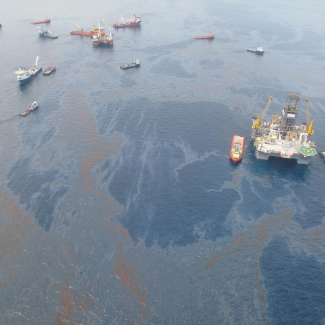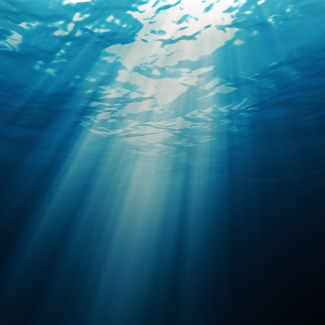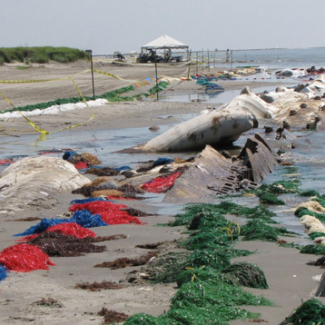
Oil Spills
Oil is an ancient fossil fuel that we use to heat our homes, generate electricity, and power large sectors of our economy. But when oil accidentally spills into the ocean, it can cause big problems. Oil spills can harm sea creatures, ruin a day at the beach, and make seafood unsafe to eat. It takes sound science to clean up the oil, measure the impacts of pollution, and help the ocean recover.

Juvenile Kemp's ridley sea turtle oiled in the Deepwater Horizon spill in 2010.
(Image credit: Blair Witherington/Florida Fish and Wildlife Conservation Commission)
What is oil?
Crude oil, the liquid remains of ancient plants and animals, is a fossil fuel that is used to make a wide range of fuels and products. Oil is found below ground or below the ocean floor in reservoirs, where oil droplets reside in “pores” or holes in the rock. After drilling down and pumping out the crude oil, oil companies transport it by pipes, ships, trucks, or trains to processing plants called refineries. There it is refined so it can be made into different petroleum products, including gasoline and other fuels as well as products like asphalt, plastics, soaps, and paints.

In the decades that NOAA’s Office of Response and Restoration has been providing scientific support for responses to oil and chemical spills, scientists have developed a trove of specialized tools to help them do their work, including an oil spill trajectory model. This model helps estimate how spilled oil will move on the water and how it will weather or change.
How do oil spills happen?
Oil spills are more common than you might think, and they happen in many different ways. Thousands of oil spills occur in U.S. waters each year. Most of these spills are small, for example when oil spills while refueling a ship. But these spills can still cause damage, especially if they happen in sensitive environments, like beaches, mangroves, and wetlands.
Large oil spills are major, dangerous disasters. These tend to happen when pipelines break, big oil tanker ships sink, or drilling operations go wrong. Consequences to ecosystems and economies can be felt for decades following a large oil spill.
Where do oil spills happen?
Oil spills can happen anywhere oil is drilled, transported, or used. When oil spills happen in the ocean, in the Great Lakes, on the shore, or in rivers that flow into these coastal waters, NOAA experts may get involved. The Office of Response and Restoration’s mission is to develop scientific solutions to keep the coasts clean from threats of oil, chemicals, and marine debris.


When oil or chemicals spill into coastal U.S. waters, the U.S. Coast Guard is the primary federal government agency charged with overseeing the response. To assist them, NOAA’s Office of Response and Restoration is mandated to provide science-based expertise to help them make informed decisions during these emergency operations.
How do oil spills harm or kill ocean life?
Where the oil is spilled, what kinds of plants, animals, and habitats are found there, and the amount and type of oil, among other things, can influence how much harm an oil spill causes. Generally, oil spills harm ocean life in two ways:
Fouling or oiling: Fouling or oiling occurs when oil physically harms a plant or animal. Oil can coat a bird’s wings and leave it unable to fly or strip away the insulating properties of a sea otter’s fur, putting it at risk of hypothermia. The degree of oiling often impacts the animal’s chances of survival.
Oil toxicity: Oil consists of many different toxic compounds. These toxic compounds can cause severe health problems like heart damage, stunted growth, immune system effects, and even death. Our understanding of oil toxicity has expanded by studying the effects of the 2010 Deepwater Horizon oil spill.
Wildlife recovery, cleaning, and rehabilitation is often an important part of oil spill response. However wildlife is difficult to find and catch, oil spills can happen over wide areas, and some animals (like whales) are too big to recover. Unfortunately, it’s unrealistic to rescue all wildlife impacted during oil spills.

When you think of California, some of the first things that come to mind might be sandy beaches, surfing, or sea otters floating in the kelp beds off the coast. It makes sense—the state has 3,427 miles of tidal shoreline! Along with these wild and wonderful natural resources, many important human resources line the coasts of the Golden State as well. Protecting these resources over thousands of miles is a tough job, but the first step is knowing what is there to protect.





 on the uploaded document.
on the uploaded document.
0 General Document comments
0 Sentence and Paragraph comments
0 Image and Video comments
General Document Comments 0

